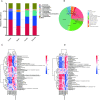A review of Duhuo Jisheng decoction mechanisms in intervertebral disc degeneration in vitro and animal studies
- PMID: 37322524
- PMCID: PMC10273736
- DOI: 10.1186/s13018-023-03869-4
A review of Duhuo Jisheng decoction mechanisms in intervertebral disc degeneration in vitro and animal studies
Abstract
Intervertebral disc degeneration (IVDD) has become a serious public health problem, placing a heavy burden on society and the healthcare system. Its pathogenesis is not completely clear and may be closely related to mechanical damage, inflammatory factors, oxidative stress and death of nucleus pulposus cells (NPCs). The treatment of IVDD mainly includes conservative treatment and surgery. Conservative treatment is based on hormonal and anti-inflammatory drugs and massage techniques, which can relieve the pain symptoms to a certain extent, but cannot solve the problem from the root cause. Surgical treatment is mainly by removing the herniated nucleus pulposus, but it is more traumatic for IVDD patients, expensive and not suitable for all patients. Therefore, it is extremely important to clarify the pathogenesis of IVDD, to find an effective and convenient treatment and to further elaborate its mechanism of action. The effectiveness of traditional Chinese medicine in the treatment of IVDD has been well demonstrated in clinical medical research. We have been working on the Chinese herbal formula Duhuo Jisheng Decoction, which is a common formula for the treatment of degenerative disc disease. Not only does it have significant clinical effects, but it also has few adverse effects. At present, we found that its mechanism of action mainly involves regulation of inflammatory factors, reduction of apoptosis and pyroptosis of NPCs, inhibition of extracellular matrix degradation, improvement of intestinal flora, etc. However, a few relevant articles have yet comprehensively and systematically summarized the mechanisms by which they exert their effect. Therefore, this paper will comprehensively and systematically explain on it. This is of great clinical significance and social value for elucidating the pathogenesis of IVDD and improving the symptoms of patients, and will provide a theoretical basis and scientific basis for the treatment of IVDD with traditional Chinese medicine.
Keywords: Duhuo Jisheng decoction; Intervertebral disc degeneration; Molecular mechanism; Traditional Chinese medicine.
© 2023. The Author(s).
Conflict of interest statement
The authors declare that they have no known competing financial interests or other interests that might be perceived to influence the results and/or discussion reported in this paper.
Figures






Similar articles
-
Duhuo Jisheng decoction alleviates intervertebral disc degeneration by inhibiting nucleus pulposus cell ferroptosis via the exosome-mediated miR-19b-3p/ACSL4 axis.Phytomedicine. 2025 Oct;146:157113. doi: 10.1016/j.phymed.2025.157113. Epub 2025 Jul 30. Phytomedicine. 2025. PMID: 40774008
-
Mechanisms of inhibition of nucleus pulposus cells pyroptosis through SDF1/CXCR4-NFkB-NLRP3 axis in the treatment of intervertebral disc degeneration by Duhuo Jisheng Decoction.Int Immunopharmacol. 2023 Nov;124(Pt A):110844. doi: 10.1016/j.intimp.2023.110844. Epub 2023 Aug 28. Int Immunopharmacol. 2023. PMID: 37647678
-
Duhuo jisheng decoction suppresses matrix degradation and apoptosis in human nucleus pulposus cells and ameliorates disc degeneration in a rat model.J Ethnopharmacol. 2020 Mar 25;250:112494. doi: 10.1016/j.jep.2019.112494. Epub 2019 Dec 24. J Ethnopharmacol. 2020. PMID: 31874213
-
ASIC1a mediated nucleus pulposus cells pyroptosis and glycolytic crosstalk as a molecular basis for intervertebral disc degeneration.Inflamm Res. 2025 Jan 28;74(1):29. doi: 10.1007/s00011-025-02003-w. Inflamm Res. 2025. PMID: 39870819 Review.
-
Exploration of the mode of death and potential death mechanisms of nucleus pulposus cells.Eur J Clin Invest. 2024 Sep;54(9):e14226. doi: 10.1111/eci.14226. Epub 2024 Apr 17. Eur J Clin Invest. 2024. PMID: 38632688 Review.
Cited by
-
Ferroptosis: A New Direction in the Treatment of Intervertebral Disc Degeneration.Cell Biochem Biophys. 2025 Mar;83(1):33-42. doi: 10.1007/s12013-024-01468-6. Epub 2024 Aug 5. Cell Biochem Biophys. 2025. PMID: 39102089 Review.
-
Analysis of Key Differential Metabolites in Intervertebral Disc Degeneration Based on Untargeted Metabolomics.JOR Spine. 2025 Jan 8;8(1):e70032. doi: 10.1002/jsp2.70032. eCollection 2025 Mar. JOR Spine. 2025. PMID: 39781087 Free PMC article.
-
Duhuo Jisheng Decoction regulates intracellular zinc homeostasis by enhancing autophagy via PTEN/Akt/mTOR pathway to improve knee cartilage degeneration.PLoS One. 2024 Jan 2;19(1):e0290925. doi: 10.1371/journal.pone.0290925. eCollection 2024. PLoS One. 2024. PMID: 38166086 Free PMC article.
-
Identifying critical modules and biomarkers of intervertebral disc degeneration by using weighted gene co-expression network.JOR Spine. 2024 Oct 18;7(4):e70004. doi: 10.1002/jsp2.70004. eCollection 2024 Dec. JOR Spine. 2024. PMID: 39430414 Free PMC article.
-
Targeting nucleus pulposus cell death in the treatment of intervertebral disc degeneration.JOR Spine. 2024 Dec 18;7(4):e70011. doi: 10.1002/jsp2.70011. eCollection 2024 Dec. JOR Spine. 2024. PMID: 39703198 Free PMC article. Review.
References
Publication types
MeSH terms
Substances
Grants and funding
- 22ZDYF512/the Sichuan Science and Technology Department Project Development Project
- 2020LC0228/Traditional Chinese Medicine scientific research of Sichuan Science and Traditional Chinese Medicine Administration
- 2021LZXNYD-D02/Luzhou Municipal People's Government - Southwest Medical University science and technology strategic cooperation climbing project
- 2022-SYF-42/Luzhou city science and technology research and development projects
- 2022YFS0609-B3/Sichuan Provincial Science and Technology Plan Joint Innovation Special Project
LinkOut - more resources
Full Text Sources
Medical

